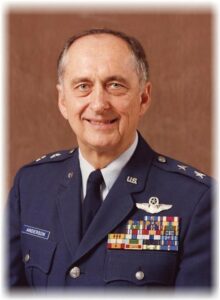John Anderson, Jr., MGen USAF, Ret., “Headed West” on June 15, 2014.
 Major General Anderson retired in March, 1993 after a career in the US Air Force and Air National Guard which spanned 38 years from start to finish.
Major General Anderson retired in March, 1993 after a career in the US Air Force and Air National Guard which spanned 38 years from start to finish.
He graduated from Cocoa High School in 1951, and entered the Georgia Institute of Technology that same year, graduating in 1955 with a degree in Engineering and a commission in the Air Force, earned through the ROTC program. Following pilot training and advanced gunnery training, he then served tours at Soesterberg AB, Holland, Cannon AFB, NM, and an exchange tour with the U.S. Navy.
During the 4 years he was assigned at Cannon AFB, he completed rotational tours in Turkey, Japan, and Korea He participated in the first Composite Air Strike Force deployment across the Atlantic and also deployed to France for the Berlin Crisis. He served special tours in Dhahran and Jidda, Saudi Arabia and Tehran and Isfahan, Iran. He led a detachment of 8 F-100 aircraft to Takhli AB, Thailand, after accepting the aircraft in Okinawa and served as the unit’s Operations Officer for 4 months.
John then returned to the US and began an exchange tour with the US Navy. After aircraft carrier checkout, he made a combat cruise aboard the USS Ranger, compiling 250 carrier landings and 165 combat missions into North Vietnam.
In 1967, he left the Air Force and went to work as a pilot for United Airlines. After a few years, he returned to the military as a pilot with the Massachusetts Air National Guard, while continuing to also fly for UAL. He served as Operations Officer and after 4 years, as Squadron Commander of the 101 51 Ftr Sqdn. He then was named Director of Operations and then Vice Wing Commander of the 1 02nd Ftr Wing at Otis AFB on Cape Cod, before being named Commander of the Air National Guard for the State of Massachusetts, where he was responsible for command, control and supervision of the state’s 29 units and some 3000 personnel.
On 1 January 1991, General Anderson was assigned as ANG Assistant to the Commander, US Space Command and held that position until his retirement. While there, he represented the Air Defense community in all matters with the multiple Headquarters and Directorates of NORAD (North American Air Defense), the United States Air Force, Air Combat Command, the NORAD regions, States, ANG units and the National Guard Bureau. He contributed to the counter drug interface between NGB and NORAD and operational and tactical control procedures benefitting the FAA, DEA, Customs, NORAD and the ANG. Under his direction and with the concurrence of Air Force Space Command, five concept of operations studies were completed and submitted for consideration of ANG involvement in space programs such as mobile communications, launch control, etc.
As a result of these proposals, 100% of the primary NORAD gained fighter squadrons are ANG units, 1st Air Force is commanded and manned by the Guard , all regional and sector control centers are likewise and the ANG now operates a missile space organization.
General Anderson has almost 6,000 hours of flying time in T-28, T-33, T38, F-86, F-100, A-4, F-9F, F-4, F-106, A-10, F-15, and F-16 aircraft. His awards and decorations include the Distinguished Service Medal, Distinguished Flying Cross(2), Meritorious Service Medal, Air Medal(16), Air Force Commendation Medal, Navy Commendation Medal w/Combat “V”, Air Force Outstanding Unit Award(2), Navy Outstanding Unit Award, Combat Readiness Medal, National Defense Service Medal , Armed Forces Expeditionary Medal(2) Vietnam Service Medal.
A funeral service was held on June 21, 2014, at the Life Event Center at Florida Memorial. General Anderson is buried at Cape Canaveral National Cemetery in Florida.
